1. Which one of the following cushions the foetus during development?
A. Chorion.
B. Amniotic fluid.
C. Placenta.
D. Uterus.
2. Which of the following sets of bones make up the hind limb in humans?
A. Radius, tibia, fibula.
B. Femur, tibia, fibula.
C. Tibia fibula, humerus.
D. Tibia, radius ulna.
3. Which one of the following associations is parasitic?
A. Bacteria in root nodules.
B. Bacteria in the rumen of herbivores.
C. Bacteria in the gut of termites.
D. Tape worm in the gut of humans.
4. The larva of a housefly moults a number of times before it pupates in order to
A. Breathe more easily.
B. Pass out waste products.
C. Increase in size.
D. Move faster.
5. Which one of the following adaptations of leave is not important for the uptake of carbon dioxide during photosynthesis?
A. Well distributed network o veins.
B. Large air spaces in spongy on leaf surface
C. Large number of stomata on leaf surface.
D. Flat and broad shape of a leaf.
6. To which one of the following does humus contribute least in the soil?
A. Improving aeration
B. Reducing soil erosion
C. Improving water retention
D. Increasing soil fertility.
7. Which one of the following is not a structural adaption of leaves to reduce water loss by transpiration?
A. Hairy lamina
B. Thin lamina.
C. Waxy cuticle.
D. Sunken stomata.
8. Which one of the following features is used to determine whether leaves are compound?
A. Types of venation.
B. Presence or absence of leaflets.
C. Types of stalk.
D. Nature of margin.
9. Figure 1 shows an example of food web.
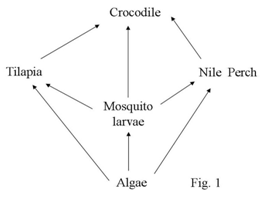
What would happen if the Nile perch were removed from the food web?
A. T tilapia population would increase.
B. Crocodile population would increase.
C. Population of algae would decrease.
D. Population of mosquito larvae would decrease.
10.Below are some characteristics features of non-flowering plants
(i) Lack vascular tissues.
(ii) Have roots, stems and leaves.
(iii) Have rhizoids. Reproduce by spores
(iv) Have thallus.
Which of the following characteristics are common to the division of ferns?
A. (I)and(V)
B. (iii) and (v)
C. (ii) and (iv)
D. (i) and (iii)
11. Which one of the following sets of car are first soaked in sodium hydrates are monosaccharaides?
A. Lactose ,maltose, sucrose
B. Lactose, maltose ,glycogen
C. Sucrose, lactose, cellulose.
D. Glucose fructose galactose.
12.When setting up an a experiment to show that energy is released by germinating seeds, the seeds are first soaked in sodium hypochlorite, in order to
A. Provide proper PH for germination.
B. Provide nutrients for germination.
C. Kill fungal spores that can release energy.
D. Absorb carbon dioxide that interferences with the experiment.
13. Which one of following conditions may result from under secretion of thyroxin?
A. Enlarge thyroid gland.
B. Protruding eye balls.
C. Increased metabolism.
D. Loss of weight.
14. Which one of the following is not correct about growth in plants?
A. Plants grow through out life.
B. Higher plants grow in phases.
C. Higher plants grow in limited parts.
D. Growth in plants is during young stage.
15. Which one of the following is a difference between tropic responses and nastic responses?
|
|
Tropic responses |
Nastic responses |
|
A |
Are growth movement |
Not growth movement |
|
B |
Not caused by hormones |
Caused by hormones. |
|
Take place in growing tips of plant |
Not restricted to growing tips |
|
|
D |
Do not depend on the direction of stimulus |
Depend on direction of stimulus |
16.Which one of the following happens when the eye is focused on a near object?
A. Ciliary muscles relax.
B. Lens becomes long and thin.
C. Suspensory ligaments contract.
D. Lens becomes shot and thick.
17. Which one of the following results into a diploid zygote I in a flowering plant? Fusion of one male nucleus with the
A. egg cell.
B. Polar nuclei.
C. synergids.
D. Antipodal cells.
18. A sample of soil previously dried in an oven was heated to red hot until smoke stopped coming out. What was the percentage of humus in the soil sample if, the weight of the soil was a and the weight of strongly heated soil was= b?
A. Enable the cells carry more oxygen.
B. Reduce the weight of the cells.
C. Allow the cells pass through capillary walls.
D. Allow the cells fit into narrow human of capillaries.
19. The significance of the biconcave shape of red blood cells is to
A. Enable the cells carry more oxygen.
B. Reduce the weight of the cells.
C. Allow the cells pass through capillary walls.
D. Allow the cells fit into narrow human of capillaries.
20. The difference between endotherms and ectoderms is that ectoderms
A. Are more active than endotherms.
B. Cannot regulate their body temperature.
C. gain less heat than endotherms.
D. Eat more food than endotherms.
21. The disadvantage the amoeba has in using binary fusion, is that,
A. The process is slow.
B. It occurs only in aquatic environment
C. Few offspring are produced.
D. There is no variation among the offspring.
22. What percentage of offspring will have blood group Of a man heterozygous for blood group B marries a woman heterozygous for blood group A?
A. 100%
B. 75%
C. 50%
D. 25%
23. Which one the following is a characteristic of Arachnids?
A. Lack antennae.
B. Have compound eyes
C. Have many appendages.
D. Have three body parts.
24. Which of the following pairs of enzymes is contained in the juice secreted by the pancreas?
A. Amylase and pepsin.
B. Trypsin and amylase.
C. Maltase and sucrose.
D. Peptidase and lactase.
25. To which one of the following phyla does the organism in figure 2 belong?
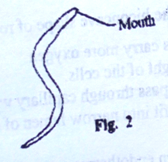
Annelida.
B. Nemstoda
C. Coelenterata.
D. Platyhelminthes.
26. . The sites of gaseous exchange in insect and mammals are respectively ,
A. spiracles and lungs
B. trachea and bronchioles.
C. tracheoles and alveoli.
D. spiracles and trachea.
27. Which one of the following activities causes changes in the carbon dioxide balance of the atmosphere?
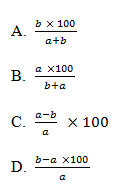
25. Which one of the following is common to both aerobic and anaerobic respiration in plants?
A. Production of water.
B. Formation of alcohol
C. Production of carbon dioxide.
D. Using up of oxygen.
26. Which one of the following is correct about saprophytic nutrition?
A. Food is taken in small fragments
B. Food is digested inside the hyphae of the saprophyte.
C. Only the liquid part of food is absorbed.
D. Food is digested externally and the resultant absorbed.
27. Which one of the following features of a bird does not aid flight?
A. Long quill feathers
B. Hollow bones
C. Strong flight muscles.
D. Thick down feathers.
28. Figure 3 is a graph showing the effect of prolonged exercise on the secretion of insulin and glucagon hormones in a human being.
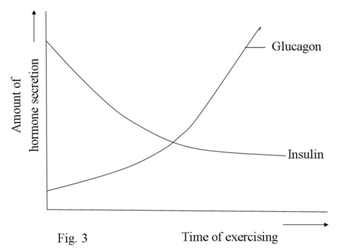
(a) Explain the variation in insulin and glucagon during the exercise.
(i) Insulin
(ii) Glucagon
(b) Suggest how concentration of the two hormones would vary if the individual swallowed much glucose after the exercise.
(i) Insulin
(ii) Glucagon
(c) Explain why it is important for the human body to secrete the insulin and glucagon.
29. Figure 4 represents germination in seeds A and B
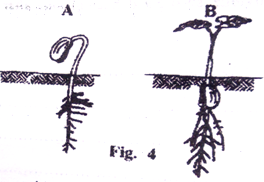
(a) Giving reasons, identify the type of germination in each seed
i. A
ii. B
(b) Explain how germination in seed A is brought about.
(c) Explain the advantage of the type of germination in seed A to the growing seedling.
30. A solution containing starch and glucose was put in a visking tube in the set-up shown in figure 5 and left to stand for 30 minutes
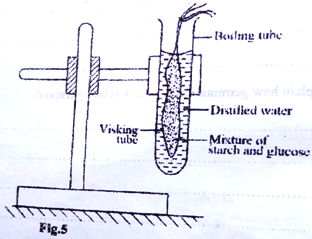
After 30 minutes, samples were drawn from the contents of it’s the visking tube and boiling tube, then iodine and iodine and Benedict’s tests carried out on each of them.
(a) Describe what was observed with iodine test on
(i) Visking tube content
(ii) Boiling tube content.
(b) Explain your observations in (a).
(c) Describe what was observed with benedict’s test on
(i) visking tube content
(ii) Boiling tube content.
(d) Explain your results in (c )
(e) Giving reasons, state the nature of the visking tube
34. (a) differentiate between fertilization and implantation
(b) Explain the advantages of internal fertilization.
(c) Describe how the placenta is adapted to carrying out is functions
35. (a) Describe the benefits of transpiration to a plant.
(b) Explain how each of the following forces contribute to the movement of water and mineral salts up the xylem vessels of a plant.
(i) Transpiration pulls
(ii) Adhesion.
(iii) Capillarity.
36. (a) Explain how lungs are adapted to their function as respiratory organs.
(b) Explain why an amoeba does not have a respiratory system.
37. What is meant by conservation of nature?
(a) How can forest be conserved) Explain the advantages of internal fertilization.
(b) Describe how the placenta is adapted to carrying out its functions.
